|
||||||||||||||||||||||||||||||||||||||||||||||||||||||||||||||||||||||||||||||||||||
|
|
||||||||||||||||||||||||||||||||||||||||||||||||||||||||||||||||||||||||||||||||||||
|
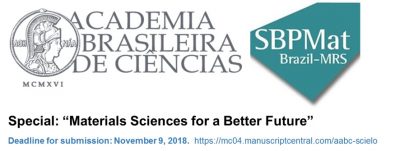 According to the editor, Frank Crespilho, professor at the São Carlos Institute of Chemistry (IQSC) at the University of São Paulo (USP) and a B-MRS member, this is a great opportunity to celebrate the success of Brazilian research in the area of Materials. Crespilho adds that the theme of the special event is in tune with the title of the memorial lecture that professor Fernando Galembeck will deliver at the XVII B-MRS Meeting, an event to be held at Praiamar Natal Hotel in Natal (Brazil), from September 16 to 20 of 2018. Furthermore, this special volume is part of the continuation of the centenary celebrations of the Academy.
According to the editor, Frank Crespilho, professor at the São Carlos Institute of Chemistry (IQSC) at the University of São Paulo (USP) and a B-MRS member, this is a great opportunity to celebrate the success of Brazilian research in the area of Materials. Crespilho adds that the theme of the special event is in tune with the title of the memorial lecture that professor Fernando Galembeck will deliver at the XVII B-MRS Meeting, an event to be held at Praiamar Natal Hotel in Natal (Brazil), from September 16 to 20 of 2018. Furthermore, this special volume is part of the continuation of the centenary celebrations of the Academy.
SBPMat members and other researchers are invited to submit their full original works through the SciELO journal’s website, from August 9 to November 9, 2018, indicating in the submission and Cover Letter their participation in the special volume.
AABC publications have no cost to authors and can be accessed freely. The AABC have been engaged in the publication of special volumes, covering all areas of science. Recently, the journal has published articles for the special “Brazil: Frontiers of Chemical Sciences,” which can be freely accessed at: http://www.scielo.br/scielo.php?script=sci_issuetoc&pid=0001-376520180002&lng=en&nrm=iso.

B-MRS member Victor Carlos Pandolfelli, professor in the Department of Materials Engineering at the Federal University of São Carlos (DEMa-UFSCar), was reelected as a member of the advisory board of the World Academy of Ceramics (WAC) to fulfill his second 4-year term (2018 to 2022). The board will include the Brazilian researcher, along with Professor Gary Messing (Penn State) and Dr. M. Singh (NASA), as representatives of the Americas.
In order to be part of the WAC advisory board, it is necessary to be a member of the Academy and be elected by vote of the members of the same region of the planet (in this case, the American continent). The names of the most voted must be endorsed by the presidency of the Academy. To be a member of the WAC, one must undergo a selection process that includes nomination by two effective members, evaluation of the application by a peer committee selected by the Academy, and final approval by at least ten of the twelve members of the advisory board.
According to Professor Pandolfelli, some of the activities he will hold in the council over the next four years are: reviewing the WAC admission rules, defining the members who will participate in the new candidate selection processes, defining the topic and speakers for technical presentations and awards in the scientific forum for members of the Academy.
The inauguration and first meeting of the new council will be held next June in Perugia (Italy).
|
|||||||||||||||||||||||||||||||||||||
|
|||||||||||||||||||||||||||||||||||||
|
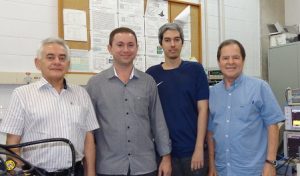
A Brazilian scientific team announced in Nature Physics (impact factor 22,806), a remarkable novelty about the atomic and subatomic dimension of nature, object of Quantum Physics, in which tiny particles that also behave like waves move around without stopping.
The team, led by Professor Sergio Machado Rezende, was able to experimentally detect, for the first time in science history, phonons with spin – something like a collective vibration of interconnected atoms (phonon) spinning around an axis (spin). “Never had anybody observed a phonon with spin before these experiments,” contextualizes Prof. Rezende (Federal University of Pernambuco, UFPE).
The research was entirely carried out in the Department of Physics of UFPE, with funding from Brazilian research support agencies (CNPq, CAPES and FINEP and FACEPE).
The spin is a property of subatomic particles, and it is the origin of magnetic properties in materials. In a first approach to the concept, it can be represented as a rotational movement of the particle.
The discovery could have an important effect on the so-called “spintronics,” both from a fundamental (understanding of phenomena) and applied point of view. Just as electronics uses the electric charge of electrons to develop technology, the still incipient spintronics takes advantage of spin to encode and store data, transport, and decode them. That is why the evidence presented in the article of Nature Physics opens possibilities of employing phonons in the development of spintronic devices.
The research was developed within the PhD thesis of José Holanda da Silva Júnior, defended on April 20 of this year at UFPE, and guided by Professor Sergio Rezende (known for having held the position of Minister of Science and Technology in Brazil from 2005 to 2010).
The idea of the thesis work was to generate a spin wave (a collective excitement of spins) into a ferromagnetic material and convert it into an elastic wave (a collective vibration of a network of atoms). In quantum terms, the goal was to convert “magnons” into “phonons” – a transformation that can be achieved since in ferromagnetic materials the motion of spins can cause vibrations in the network of atoms.
The idea of the magnon-phonon conversion was well studied in the 1960s and 1970s, Rezende comments. However, at that time it was not possible to obtain clear experimental evidence of the conversion, since the materials available to make the experiments limited the observation of the effect. “Cylinders of ferromagnetic materials were used,” says Rezende. “The effect occurred, but it was inside the material and there was no way to test if it was actually occurring,” he adds. To obtain definitive evidence, it was necessary to use very thin layers of ferromagnetic material.
In the last 20 years, explains Rezende, technology has been developed to make thin films of various materials. As a result, the academic interest in magnon-phonon conversion has returned, generating numerous advances in the understanding of the phenomenon in the last decade.
In this new context, José Holanda, his advisor Prof. Rezende and collaborator Prof. Antônio Azevedo da Costa were able to manufacture a thin film of the most suitable ferromagnetic material to study the magnon-phonon conversion, the yttrium and iron grenade. With this thin film, the team prepared samples in the form of tapes of 2 x 12 square millimeters of surface and 8 micrometers of thickness, and used them to perform two types of major experiments.
The first consists, in broad lines, of applying microwave radiation to one of the two ends of the film, generating spin excitations in the material. Consequently, the spin is oriented around the magnetic field that is applied (phenomenon known as “precession”). This collective precession starts at one end of the sample and propagates as a real “spin wave” until it reaches the other end.
If the magnetic field applied to the sample is uniform, the spin wave attenuates itself and does not become an elastic wave. Therefore, the Pernambuco team used rare earth magnets (one at each end of the sample) to cause variations in the magnetic field along the film, following the spin wave displacement.

The experiments with microwaves generated evidence that the magnon-phonon conversion was taking place, but the group considered it important to confirm, or not, the results through measurements of the so-called Brillouin scattering. In this experiment, laser light is applied at some point in the sample and the scattered light is analyzed. The result allows determining the nature of the excitation (in this case, magnon or phonon) that is interacting with light. “The great advantage of using a film instead of a massive material is that you can focus the laser at any position in the film and can vary the angle of incidence,” explains Rezende.
Through Brioullin scattering, the team not only could verify that the spin wave (magnon) subjected to a non-uniform magnetic field had actually converted into an elastic wave (phonons), but also they came upon a surprise: these phonons spread circularly polarized light. – evidence that they had spin. “We did not expect that the phonon produced by the conversion of the magnon also had a certain rotation motion, which is what we call spin,” says Rezende.
After making this discovery experimentally, the team made the corresponding theoretical calculations. “We confirmed that the theory actually predicted that the phonon had spin, but we did not know the theory before,” Professor Rezende reveals.
[Paper: Detecting the phonon spin in magnon–phonon conversion experiments. J. Holanda, D. S. Maior, A. Azevedo & S. M. Rezende. Nature Physics (2018) doi:10.1038/s41567-018-0079.]
Instructions for authors: https://www.sbpmat.org.br/17encontro/authors/
|
|||||||||||||||||||||||||||||||||||||||||
|
|||||||||||||||||||||||||||||||||||||||||
|
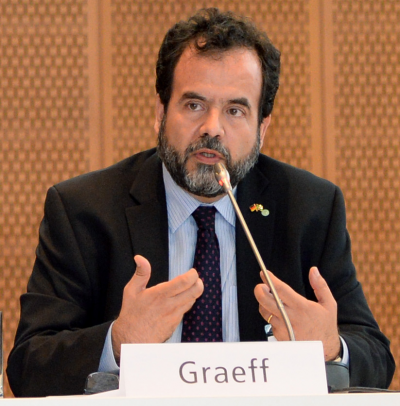
Fascinated by science since he was a child, with a representative at his home (his father, a renowned neuroscientist), Carlos Frederico Oliveira Graeff, born at Ribeirao Preto (state of São Paulo), chose the area of Physics as his university studies. He obtained his bachelor’s (1989), master (1991) and doctor (1994) degrees in Physics from the University of Campinas (Unicamp). During his master’s and doctorate program, supervised by professor Ivan Chambouleyron, he took his first steps as a researcher in the Materials area with studies on materials based on germanium and silicon. During his doctorate he participated in a research internship at the Max Plank Institut für Festkörperforschung in Germany.
He returned to Germany in 1994 until 1996 for a postdoctoral period to work on electronic magnetic resonance, semiconductors and electronic devices at the Walter Schottky Institute of the Technische Universität München (TUM), with a grant from the German foundation Alexander Von Humboldt.
Upon returning to Brazil, he became a professor at the Department of Physics and Mathematics of the University of São Paulo (USP), where he remained for 10 years. In 2006, he joined the Faculty of Sciences of Bauru at the State University of São Paulo (UNESP) as a full professor, where he is still teaching and researching. Throughout his academic career, Graeff has been visiting professor or researcher at several institutions in France, China and Switzerland.
From 2007 to 2009, Graeff was coordinator of the Post-Graduate Program in Materials Science and Technology (POSMAT) at UNESP – Bauru campus. Between 2009 and 2014, he was the coordinator of the newly created Materials Area of CAPES, responsible for the evaluation of Brazilian post-graduate programs in Materials, among other functions. From 2011 to 2013, Graeff was president of the Humboldt Club of Brazil and in 2012 and 2013 he was scientific director of B-MRS. The scientist also fulfilled or performs management or advisory functions at Brazilian agencies FAPESP and CAPES, and at IUPAC (International Union of Pure and Applied Chemistry).
In 2017, after having participated in the editorial board of several international journals, he was appointed associate editor in the photovoltaic area of the journal Solar Energy (impact factor 4,018), of Elsevier publishing house. Also in 2017, he became Dean of Research at UNESP, a post he holds until now.
With an h index of 28, Graeff is the author of about 200 indexed papers that have more than 2,500 citations, according to Google Scholar. In three decades of scientific work, together with his team at the Laboratory of New Materials and Devices at UNESP and his numerous national and international collaborators, Graeff has contributed to the field of materials research with multiple subjects. Among his most cited articles there are studies on synthetic diamond, silicon and germanium heterostructures, conjugated polymers, latex and melanin (biological material with semiconductor properties that are promising for the development of bioelectronic devices).
The researcher has also worked in the area of photovoltaic energy (direct conversion of solar radiation into electricity), with numerous contributions to the development of solar cells based on different materials (dyes, perovskites and organic semiconductors). On this subject of photovoltaic energy, Carlos Graeff will offer a plenary lecture at the XVII B-MRS Meeting, to be held in Natal (RN) from September 16 to 20.
The following is an interview with this outstanding researcher of our community.
B-MRS Newsletter: How or why did you become a scientist? Did you always want to be a scientist? Also, briefly tell us what led you to work in the field of materials.
Carlos Graeff: My father, Frederico Graeff, is a well-known researcher and perhaps one of the most important influences in my decision. My aunts were also teachers and researchers, so from an early age I had access to the world of science from my home, which has always fascinated me. The decision to study physics was largely due to the various books I read and from the television Cosmos series presented by Carl Sagan. The decision to work in the Materials area came later on during my baccalaureate in physics after the first courses in condensed matter physics and semiconductors. From the beginning of the graduate studies I worked in materials, and soon I was attracted by the interfaces of physics with chemistry and biology in very different subjects of materials science and engineering.
B-MRS Newsletter: What do you believe are your main contributions to the Materials area? Please consider all aspects of scientific activity.
Carlos Graeff: It is always difficult to choose key contributions. In my case in particular it is easy to see, reading my CV, a very eclectic trajectory in terms of studied materials and applications. Using originality as a preference, I will dwell on three themes; the first is the production of CoS (cobalt sulfide) the basis of ecological paints for the production of electrodes for solar cells. We have achieved a simple, industrial and ecological method to replace platinum in dye-based solar cells. In the second theme, we have proposed several alternative methods for the synthesis of melanin, the material involved in tanning, and with this we have been able to produce biocompatible materials with very special characteristics with regard to, for example, solubility. We are identifying a very important defect for this material using, as a main tool, computational simulations combined with spectroscopic techniques. We are sure this material will be important in the emerging area of bioelectronics. In the third theme, we describe in detail the whole degradation process of organic semiconductors, identifying routes for the production of high sensitivity dosimeters for applications in hospitals and clinics that use, for example, gamma rays for cancer treatments and diagnosis. We also have had very unique contributions in the physics of electrically detected magnetic resonance, increasing the sensitivity and the general understanding of the physical phenomena involved. In addition to these fundamental contributions, I was responsible, proudly and with satisfaction, for the implementation of the materials area at CAPES. Another source of satisfaction regards the good students I was fortunate enough to mentor, many of them brilliant scientists. I helped and coordinated the assemblage of several laboratories both here in Brazil and abroad, most recently I helped set up a magnetic resonance laboratory in China.
B-MRS Newsletter: Now we invite you to leave a message for our readers who are starting their scientific careers.
Carlos Graeff: I started my master’s degree in 1989, a time that was perhaps as troubled as the current one, do not get discouraged! With focus and a bit of luck it is always possible to create new ideas, build a solid career and contribute to our beautiful country. We are going through a great revolution, with the emergence of new technologies that will profoundly transform society. Intelligence will increasingly play a decisive role in the direction of our society, be prepared to work in this new world of great opportunities. Always seek out dialogue with specialists from the most different areas of knowledge and from various countries. Quite possibly, in the coming years we will unravel the mysteries of how the brain works, we will master limitless forms of energy and ecological production, generate artificial intelligence. Open up to what is new, be bold, Brazil needs your citizen and entrepreneurial spirit.
B-MRS Newsletter: You will deliver a plenary lecture at the XVII B-MRS Meeting. Leave an invitation to our community.
Carlos Graeff: Photovoltaic energy is reaching its commercial maturity, we are living an unprecedented energy revolution. In the lecture I will show some updated data on the perspectives of using photovoltaic cells in Brazil and in the world; its principles of operation; the challenges for scientists and material engineers in this relentless race for increasingly efficient, durable and environmentally friendly materials, processes and devices. I will present our group’s latest results on this topic.
[Paper: Conversion of “Waste Plastic” into Photocatalytic Nanofoams for Environmental Remediation. Geovania C. de Assis, Euzébio Skovroinski, Valderi D. Leite, Marcelo O. Rodrigues, André Galembeck, Mary C.F. Alves, Julian Eastoe, and Rodrigo J. de Oliveira. ACS Appl. Mater. Interfaces, 2018, 10 (9), pp 8077–8085. DOI: 10.1021/acsami.7b19834].
Polystyrene, from pollutant to environmental remediator
A team composed of seven researchers from Brazil and one from the United Kingdom used polystyrene waste, which is a potential environmental polluter, to produce a material that works as an environmental remediator by degrading toxic compounds in water bodies and waterways. Therefore, the research makes a contribution to two disturbing environmental problems: on the one hand, the presence of large amounts of plastic waste on the planet; on the other hand, pollution or contamination with toxic substances in aquatic ecosystems.
The research was reported in a paper recently published in the journal Applied Materials & Interfaces (impact factor = 7,504).
We know that polystyrene is used to make disposable cups and cutlery, yogurt pots, combs, hangers, organizer boxes and many other utilities, in addition to being the main component of the well-known isopor®. “We present an alternative to reuse one of society’s most demanded plastics,” says Professor Rodrigo José de Oliveira, from Paraíba State University (UEPB), corresponding author of the paper.

The material developed by the scientific team consists of a porous polymer matrix impregnated with nanoparticles of tin dioxide (SnO2). In this composite material, while the nanoparticles are largely responsible for degrading the toxic compounds (dyes) by a photocatalytic process, the polymer matrix, which is produced from polystyrene waste, creates an environment favorable to photocatalytic activity and supports the nanoparticles, allowing them to be easily removed from the waters, and reused in new processes of environmental remediation.
The authors of the article called the new composite material “nanofoam”. Although they have a few centimeters in diameter and pores of a few micrometers, the foams have received the prefix “nano” because their photocatalytic properties are due to the presence of nanometric-sized tin dioxide (spherical nanoparticles of about 20 nm). “Nanomaterials are those that present new properties due to a distinct physics that appears in this size scale,” recalls Oliveira.
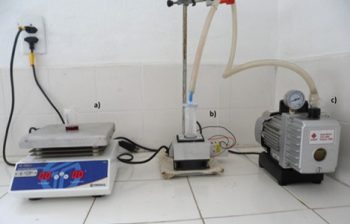
To obtain composite foams, the team used low cost equipment and procedures based on well-known physicochemical properties. The preparation process is described in broad lines as follows. First, small pieces of polystyrene waste are dissolved in cyclohexane solvent, and the tin dioxide nanoparticles, which here were manufactured by the team, are added to the solution. This part of the process is carried out above the so-called “theta temperature (θ)” of the cyclohexane and polystyrene solution, which is about 36 °C, because below this temperature the solution undergoes a phase separation. Second, the preparation is carried out for 10 minutes at a temperature of 10 °C. As a consequence of this temperature decrease, some phenomena take place. The solution separates into two phases, one rich in polystyrene and the other rich in cyclohexane, and the solvent freezes. At the end of the cooling process, the phases are distributed in such a way that they form a polystyrene structure with holes filled with frozen cyclohexane. In order to remove the solvent from the foams, a lyophilization process is applied, whereby the cyclohexane undergoes sublimation. As a final result, a porous solid is obtained that the authors of the article called nanofoam.
“We have shown that a dense polystyrene waste can be readily converted into a porous polymer matrix, which is desirable for making new materials, that is, a noble end to pollution that has mobilized governments from industrialized countries,” says Professor Oliveira.
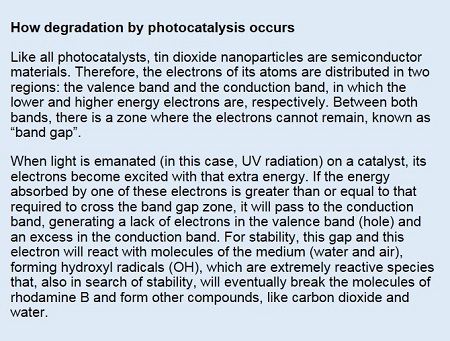 Finally, the scientific team evaluated the efficiency of the new material as an environmental remediator by testing the ability of nanofoams to degrade a magenta-like dye called rhodamine B. This compound, which is used as a marker in health, research, agriculture areas, is toxic to the reproductive and neurological system, and in some studies it has been pointed out as a carcinogenic agent.
Finally, the scientific team evaluated the efficiency of the new material as an environmental remediator by testing the ability of nanofoams to degrade a magenta-like dye called rhodamine B. This compound, which is used as a marker in health, research, agriculture areas, is toxic to the reproductive and neurological system, and in some studies it has been pointed out as a carcinogenic agent.
The nanofoams of Professor Oliveira and his collaborators managed to degrade 98.2% of rhodamine B – a result superior to those obtained with photocatalytic nanoparticles outside the polystyrene matrix. In addition, the nanofoams demonstrated very good performance when reused: they degraded more than 96% of rhodamine B in the first four cycles. “It is desirable to use a matrix because it facilitates the final recovery of the photocatalyst, since the foam is easily removed from the medium using steel tweezers, in addition to an increase in the surface area due to higher oxide dispersion in the matrix,” says Oliveira.
History of the work
Rodrigo de Oliveira was involved in his doctorate when, in 2011, he had the idea of obtaining new catalytic materials, taking advantage of the characteristic of some solutions in which their phases are separated by the effect of temperature (known as “thermally induced phase separation,” TIPS). Oliveira was in an internship abroad (the so-called “doctoral sandwich”) in the group of Professor Julian Eastoe at the University of Bristol. In this group, Oliveira had found the double possibility of working with surfactants, the subject of his doctoral research, and also improving his command of the English language. “In Bristol, Julian presented me with a paper he had published decades ago on the use of TIPS to study microemulsions and the formation of calcium carbonate foams,” Oliveira recalls. By the end of the internship, the Ph.D. work had developed a surfactant foam decorated with gold nanoparticles. In England, in addition to this work in Bristol, Oliveira made contact with a renowned group at Cardiff University dedicated to catalysis research, led by Professor Graham Hutchings. “The possibility of obtaining new catalytic materials using TIPS was cogitated,” recalls Oliveira.
In 2012, Oliveira obtained a doctor’s degree in Chemistry from the Federal University of Pernambuco (UFPE). Shortly after, after qualifying in the selection process of UEPB, he became a professor of that institution. The young researcher then saw the opportunity to realize the idea he had envisaged in England. In order to carry it out, he had to venture into a new research line, different from what he had pursued during his undergraduate, master’s and doctoral works, but he was already experienced with this. In fact, during his undergraduate, master’s and doctorate courses in Chemistry, all of them at UFPE under the guidance of Professor André Galembeck, he had addressed three very different research topics. “André has always been open to proposals and ideas, including those that differed from the group’s research history,” declares Oliveira.
There was no lack of courage, but Oliveira had just arrived at UEPB and had no infrastructure available, nor the financial resources to build it. “From 2012 to now, our struggle has been to establish a research group in physical chemistry of materials, and one of the focused lines is the use of TIPS to make materials from plastic waste,” he says. In the case of nanofoams, the researcher was able to develop the work within Geovânia Cordeiro de Assis’s master’s thesis, defended in 2016 and supervised by Oliveira together with professor Mary Cristina Ferreira Alves (co-supervisor). For the preparation of the nanofoams, the team used simple and inexpensive equipment (“a $ 20 refrigeration plate purchased from China’s import website and a vacuum pump”). For the characterizations, which necessarily require more expensive equipment, Oliveira had the collaboration of colleagues from UFPE, University of Brasilia and University of Bristol.
Other materials with environmental applications will be generated in the city of Campina Grande, in the laboratory of Professor Oliveira, using various types of plastics, including those with a more complex composition such as styrofoam®, which is composed of expanded polystyrene and other chemical components. In addition to developing materials to contribute to the remediation of ecosystems, the group is using them for more fundamental studies, which could generate nanomaterials with sophisticated structures.
“Unfortunately, we are constantly faced with the lack of characterization equipment, and nowadays neither the collaborators with the best of intentions have the resources to help us as before,” Oliveira laments. “I realize there are quality human resources in our institution; however, more investments in infrastructure are fundamental to maintain the quality of the work, training of human resources and internalization of state of art science,” he adds.
